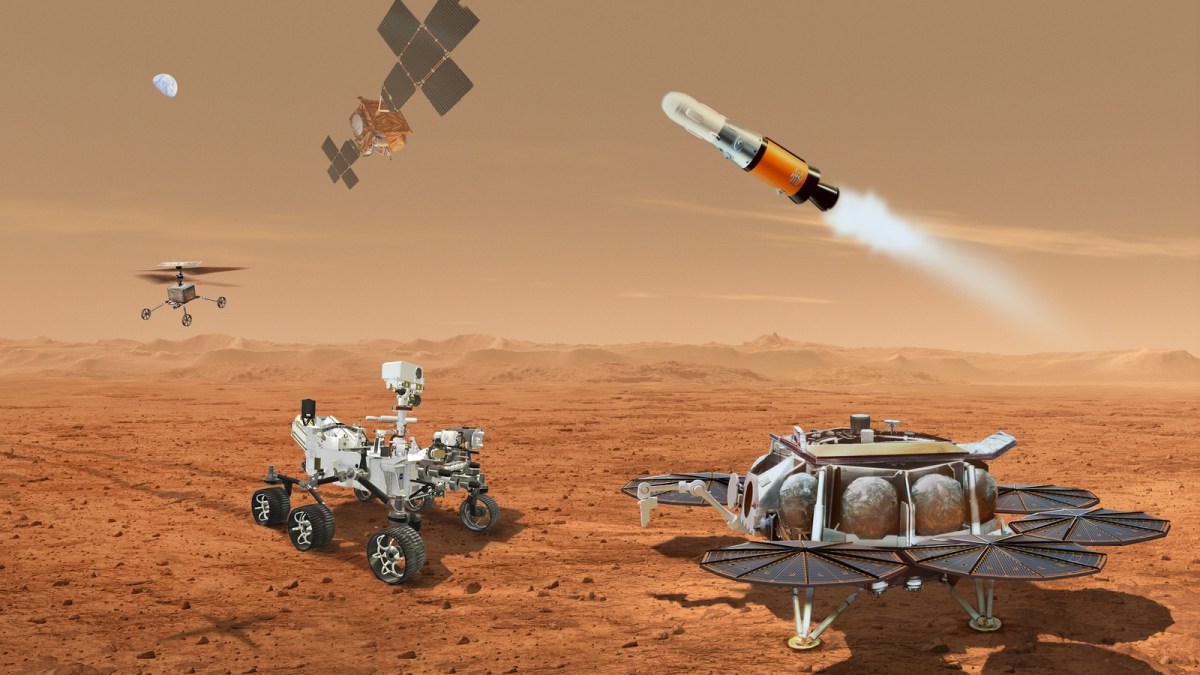WASHINGTON — NASA officials say the agency is on track to decide by the end of the year how to revise the Mars Sample Return (MSR) architecture to lower its costs and shorten its schedule.
NASA received Oct. 15 the final reports of 12 studies exploring different approaches to MSR, said Jeff Gramling, MSR program director at NASA Headquarters, at an Oct. 21 meeting of the Committee on Astrobiology and Planetary Sciences of the National Academies’ Space Studies Board.
Eight of the studies were from industry, seven awarded in June and an eighth to Rocket Lab made in August but only announced Oct. 7. The agency received 48 industry proposals for those studies, he noted. The other four came from an internal NASA team as well as from the Jet Propulsion Laboratory, Marshall Space Flight Center and a joint effort by the Applied Physics Laboratory and NASA’s Wallops Flight Facility.
Gramling said at the committee meeting that the studies fell into three categories. Those by Blue Origin, Lockheed Martin, Rocket Lab and SpaceX, as well as JPL and the NASA internal team, looked at end-to-end mission architectures. Studies by Aerojet Rocketdyne, Northrop Grumman, Whittinghill Aerospace, NASA Marshall and APL/Wallops focused on ways to reduce the size and mass of the Mars Ascent Vehicle, the rocket that would launch samples into Mars orbit to be collected and returned to Earth. The final study, from Quantum Space, looked at how its capabilities could be used for the “anchor leg” of the return, transporting the samples from cislunar space back to Earth.
Those studies are in the hands of an independent review team called the MSR Strategy Review, or MSR-SR, that NASA announced Oct. 16. That eight-person committee is chaired by former NASA administrator Jim Bridenstine and includes former NASA officials, like former James Webb Space Telescope program director Greg Robinson, as well as representatives from academia.
The MSR-SR will be supported by an internal NASA Analysis Team that includes a group of NASA officials with both technical and cost management expertise, as well former NASA chief scientist Ellen Stofan. “The chair of the strategic review team is free to leverage the NASA team to the extent he chooses,” Gramling explained. “They’re there to support the team and make sure we get the best possible results coming out of the study.”
The MSR-SR will evaluate all 12 studies, but need not recommend a specific one as the best path forward for MSR. “It doesn’t necessarily have to be one of the proposed architectures. It may be that we learn things from all of the architectures,” he said. “They take those things, pieces of them, and say this is what we think the agency ought to be doing going forward.”
The goal of the review is to provide that recommendation to agency leadership, including Administrator Bill Nelson, some time in December. “What we’re looking for is an architecture that gives us the highest likelihood of returning samples to Earth before 2040 and, if possible, for less than $11 billion,” Gramling said.
He said he was optimistic both that the effort will result in a cheaper, faster MSR program and that NASA will stay on schedule for completing that assessment. The agency laid out an “aggressive schedule” that calls for a decision on the MSR architecture by the end of the year. “We have actually held that schedule” so far through the study process, he said.
That schedule extends beyond the impending decision on MSR. Donya Douglas-Bradshaw, MSR deputy program director, told the committee that plans for getting MSR to a confirmation review, which sets formal cost and schedule commitments, will depend on when agency leadership makes its decision on the MSR architecture and how much the new one changes from the current approach. That plan includes getting to a milestone called a “delta acquisition strategy discussion” next spring, but noted that schedule is “highly success-oriented.”
While agency officials didn’t provide insights into specifics about the alternative architecture studied, the progress made since an independent review panel warned of cost and schedule problems with MSR in a September 2023 report appeared to reassure the committee.
“It seems a lot better than this time last year,” quipped one committee member, Clive Neal of the University of Notre Dame, at the end of the meeting.
